ภาพรวม
- การเข้าใจหลักการทำงานของเครื่องวัดการไหลประเภทต่าง ๆ มีความสำคัญต่อการตรวจสอบการไหลของของเหลว บทความนี้จะแนะนำหลักการทำงานของเครื่องวัดการไหลหลากหลายประเภท เช่น เครื่องวัดการไหลแบบอัลตราโซนิก แบบพื้นที่แปรผัน แบบโคริโอลิส แบบพายหมุน แบบการกระจัดเชิงบวก แบบวอร์เท็กซ์ แบบกังหัน แบบความดันต่าง แบบการไหลแบบลามินาร์ แบบแม่เหล็กไฟฟ้า และแบบมวลความร้อน เครื่องวัดเหล่านี้ใช้ปรากฏการณ์ทางฟิสิกส์และเทคโนโลยีที่แตกต่างกัน เพื่อรองรับการวัดของไหลในหลากหลายการใช้งาน
เครื่องวัดการไหล (Flow Meters) เป็นอุปกรณ์ที่ใช้งานได้หลากหลายและสำคัญในระบบการประมวลผลของเหลว ตั้งแต่การผลิตสารเคมีทางการเกษตรไปจนถึงโรงงานบำบัดน้ำ เครื่องวัดเหล่านี้ช่วยตรวจสอบประสิทธิภาพการทำงานและให้ข้อมูลสำหรับการตรวจจับปัญหาในท่อส่งของเหลว บทความนี้เน้นการทำความเข้าใจหลักการทำงานของเครื่องวัดการไหลประเภทต่าง ๆ หากต้องการข้อมูลเพิ่มเติมเกี่ยวกับข้อดี ข้อเสีย และเคล็ดลับการเลือกใช้ โปรดดูที่ "คู่มือเลือกเครื่องวัดการไหล - ข้อดีและข้อเสียของเครื่องวัดการไหล 11 ประเภท"
เครื่องวัดการไหลแบบอัลตราโซนิก (Ultrasonic Flow Meters)
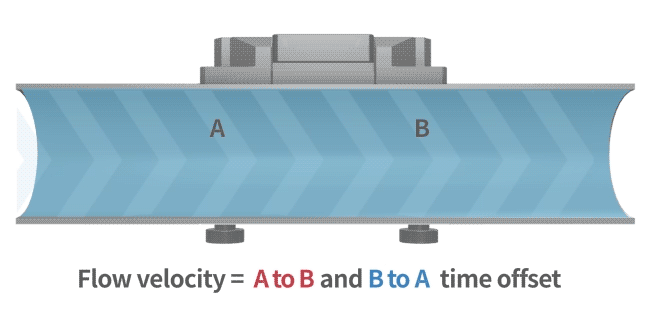
เครื่องวัดอัตราการไหลแบบอัลตราโซนิกคำนวณอัตราการไหลโดยใช้วิธีการวัดเวลาการเดินทาง (transit-time method) คลื่นอัลตราโซนิกจะเดินทางได้เร็วขึ้นและใช้เวลาน้อยลงในทิศทางเดียวกับการไหลของของไหล ในขณะที่ในทิศทางตรงกันข้าม คลื่นจะเดินทางช้าลงและใช้เวลามากขึ้น ด้วยการวัดความแตกต่างของเวลานี้ ความเร็วของการไหลของของไหลจะถูกคำนวณ (ดังที่แสดงในภาพประกอบ)
เครื่องวัดการไหลแบบอัลตราโซนิกบางรุ่นใช้วิธี Doppler ซึ่งอิงจากหลักการ Doppler effect เมื่อคลื่นอัลตราโซนิกกระทบกับอนุภาคหรือฟองอากาศที่เคลื่อนที่ในของไหล ความถี่สะท้อนจะเปลี่ยนแปลงไป โดยการวัดการเปลี่ยนแปลงของความถี่นี้ สามารถคำนวณความเร็วของการไหลได้
▪ เรียนรู้เพิ่มเติม:
เครื่องวัดอัตราการไหลแบบอัลตราโซนิกที่จดสิทธิบัตรจากไต้หวันของ LORRIC พร้อมระบบเปิดใช้งานด้วยคลิกเดียว.
เครื่องวัดการไหลแบบพื้นที่แปรผัน (Rotameters)
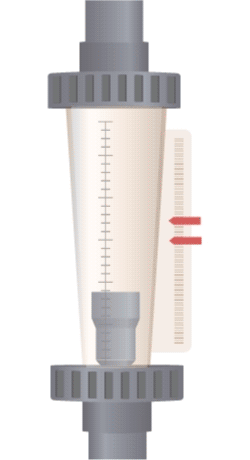
ลูกลอยถูกแขวนอยู่ในท่อที่มีลักษณะแบบเรียว (กว้างด้านบน แคบด้านล่าง) เมื่อของไหลไหลผ่านท่อ จะเกิดความแตกต่างของแรงดัน ทำให้เกิดแรงยกขึ้นที่สมดุลกับน้ำหนักของลูกลอยในตำแหน่งสมดุลที่เสถียร เมื่ออัตราการไหลเพิ่มขึ้น จำเป็นต้องมีพื้นที่หน้าตัดที่ใหญ่ขึ้นเพื่อรองรับลูกลอยในตำแหน่งสมดุล ซึ่งหมายความว่าลูกลอยจะเลื่อนขึ้นไปอยู่ในตำแหน่งที่สูงขึ้นเมื่ออัตราการไหลเพิ่มขึ้น ดังนั้น เครื่องวัดอัตราการไหลแบบพื้นที่แปรผัน (Rotameter) จะวัดอัตราการไหลโดยการสังเกตการเปลี่ยนแปลงของพื้นที่หน้าตัดที่ลูกลอยอยู่ในตำแหน่งสมดุล
▪ เรียนรู้เพิ่มเติม: เครื่องวัดอัตราการไหลแบบลูกลอย Rotameter พร้อมเข็มชี้ที่จดสิทธิบัตรจาก LORRIC ผลิตในไต้หวัน
[2]
เครื่องวัดการไหลแบบโคริออลิส (Coriolis Flow Meters)
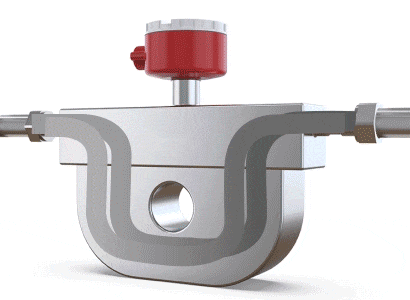
เครื่องวัดการไหลแบบโครีออลิส (Coriolis Flow Meter) ใช้ปรากฏการณ์ทางฟิสิกส์ที่เรียกว่าแรงโครีออลิส (Coriolis Force) ในการวัดอัตราการไหลของมวล (เมื่ออนุภาคเคลื่อนที่ในเส้นตรงภายในระบบหมุนที่ไม่ขนานกับการหมุน อนุภาคนั้นจะเบี่ยงเบนทิศทางเนื่องจากแรงเฉื่อยของระบบ) เมื่อของไหลไหลผ่านท่อรูปตัว U แรงโครีออลิสจะทำให้ท่อบิดตัวและสั่นเล็กน้อย ความแตกต่างของทิศทางการไหลระหว่างทางเข้าและทางออกจะทำให้เกิดการบิดของท่อรูปตัว U เซนเซอร์ที่ติดตั้งใกล้ทางเข้าและทางออกจะตรวจจับและคำนวณการสั่นสะเทือนเหล่านี้ โดยการวิเคราะห์แอมพลิจูดและความถี่ของการสั่นสะเทือน สามารถกำหนดอัตราการไหลของมวลและความหนาแน่นของของไหลได้ ทำให้เครื่องวัดนี้เหมาะสำหรับการวัดการไหลของมวลโดยเฉพาะ
▪ LORRIC มีเครื่องวัดการไหลหลากหลายประเภทให้เลือก
ติดต่อเราเพื่อรับคำปรึกษาได้เลย!
เครื่องวัดการไหลแบบพายหมุน (Paddle Wheel Flow Meters)
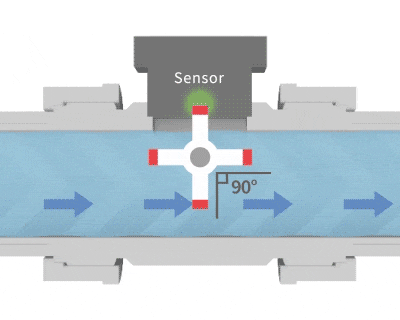
โครงสร้างคล้ายกับกังหันน้ำ เมื่อของไหลไหลผ่านจะทำให้เกิดการหมุน ส่วนประกอบโลหะแม่เหล็กที่ฝังอยู่ในใบพัดจะสร้างสัญญาณพัลส์ซึ่งตรวจจับโดยเซนเซอร์ การนับจำนวนพัลส์เหล่านี้สามารถแปลงความเร็วการไหลเป็นอัตราการไหลได้ วิธีการคำนวณของเครื่องวัดอัตราการไหลแบบพายหมุน: ปริมาตรต่อพัลส์ × จำนวนพัลส์ ÷ เวลา = อัตราการไหลทันที
▪ เรียนรู้เพิ่มเติม: เครื่องวัดอัตราการไหลแบบพายหมุนที่ได้รับสิทธิบัตรจาก LORRIC ผลิตในไต้หวัน
[4]
เครื่องวัดการไหลแบบปริมาตรบวก (Positive Displacement Flow Meters)
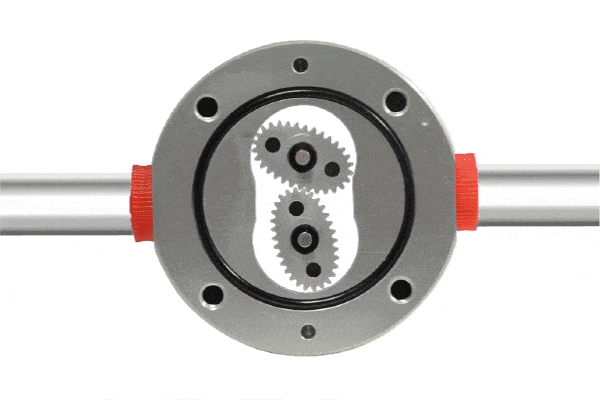
เครื่องวัดอัตราการไหลแบบ Positive Displacement มีห้องวัดปริมาตรขนาดเล็กคงที่ (เรียกทั่วไปว่าห้องวัดปริมาตร) ซึ่งใช้วัดการไหลโดยการคำนวณปริมาตรของของไหลที่ผ่านห้องนี้ซ้ำ ๆ ภายในห้องวัดปริมาตรมีการติดตั้งเฟือง (ส่วนประกอบที่หมุนได้) เมื่อของไหลไหลผ่านเครื่องวัดอัตราการไหล จะเกิดความแตกต่างของแรงดันที่ทางเข้าและทางออก ซึ่งทำให้เฟืองหมุนและผลักดันของไหลไปยังทางออกอย่างต่อเนื่อง
เนื่องจากปริมาตรของห้องวัดเป็นค่าคงที่ การวัดจำนวนการหมุนของเฟืองจึงช่วยให้สามารถกำหนดปริมาตรของของไหลที่ผ่านเครื่องวัดอัตราการไหลได้อย่างแม่นยำ โดยทั่วไป เฟืองได้รับการออกแบบให้มีความทนทานต่อสารเคมีสูง เครื่องวัดอัตราการไหลแบบ Positive Displacement มีลักษณะเด่นคือสามารถรองรับความแตกต่างของแรงดันสูง เหมาะสำหรับของเหลวที่มีความหนืดสูง และมีความแม่นยำสูง
▪ LORRIC มีเครื่องวัดอัตราการไหลหลากหลายประเภท ติดต่อเราเพื่อรับคำปรึกษาได้เลย!
[5]
เครื่องวัดการไหลแบบวอร์เท็กซ์ (Vortex Flow Meters)
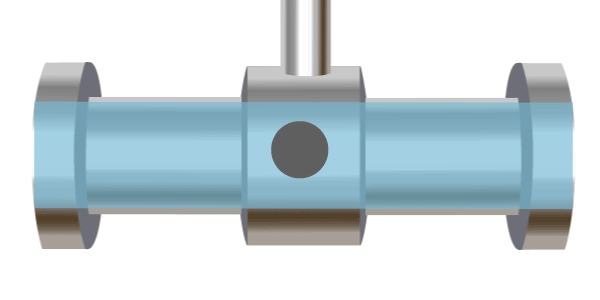
เครื่องวัดอัตราการไหลแบบวอร์เท็กซ์ (Vortex Flow Meter) ทำงานโดยอ้างอิงหลักการ Kármán Vortex Street ซึ่งตั้งชื่อตามวิศวกรและนักฟิสิกส์ชาวฮังกาเรียน-อเมริกัน Theodore von Kármán ผู้ที่อธิบายหลักการนี้ทางทฤษฎีครั้งแรกในปี 1912 โดยจะมีสิ่งกีดขวางวางอยู่ในท่อ และเมื่อของไหลไหลผ่านสิ่งกีดขวางนี้ จะเกิดการสร้างกระแสวอร์เท็กซ์ด้านหลังสิ่งกีดขวาง ความถี่ของการเกิดวอร์เท็กซ์มีความสัมพันธ์กับความเร็วของการไหล โดยทั่วไป วิธีอัลตราโซนิกจะถูกใช้ในการวัดความถี่ของวอร์เท็กซ์ ซึ่งค่าความถี่นี้จะถูกนำไปใช้คำนวณอัตราการไหล
▪ LORRIC มีเครื่องวัดอัตราการไหลหลากหลายประเภท ติดต่อเราเพื่อรับคำปรึกษาได้เลย!
[6]
เครื่องวัดการไหลแบบเทอร์ไบน์ (Turbine Flow Meters)
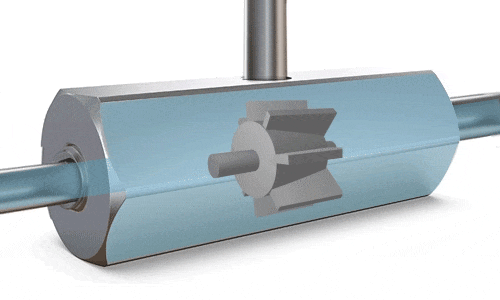
ใบพัดกังหันถูกติดตั้งอยู่ที่ศูนย์กลางของท่อในเครื่องวัดอัตราการไหล เมื่อของไหลไหลผ่าน จะเกิดแรงกระทำกับใบพัดกังหัน ทำให้ใบพัดหมุน เมื่อความเร็วรอบของการหมุนคงที่ ความเร็วรอบจะสัมพันธ์โดยตรงกับความเร็วของการไหล การตรวจจับด้วยแม่เหล็กจะสร้างสัญญาณพัลส์ ซึ่งเซนเซอร์จะแปลงสัญญาณเหล่านี้เพื่อคำนวณอัตราการไหล ความเร็วรอบ (RPM) มีความสัมพันธ์โดยตรงกับอัตราการไหล และจำนวนรอบการหมุนมีความสัมพันธ์กับปริมาตรรวมที่ไหลผ่าน
▪ LORRIC มีเครื่องวัดอัตราการไหลหลากหลายประเภท ติดต่อเราเพื่อรับคำปรึกษาได้เลย!
[7]
เครื่องวัดการไหลแบบความดันต่าง (Differential Pressure Flow Meters)
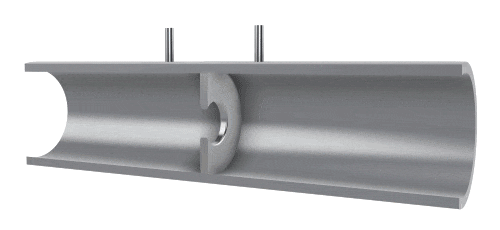
เครื่องวัดอัตราการไหลแบบความดันแตกต่าง (Differential Pressure Flow Meter) หรือที่เรียกว่าเครื่องวัดอัตราการไหลแบบคันเร่ง (Throttling Flow Meter) วัดอัตราการไหลโดยอาศัยความแตกต่างของความดันที่เกิดขึ้นเมื่อของไหลไหลผ่านอุปกรณ์คันเร่ง โดยใช้รูเจาะที่มีความแม่นยำ ความดันจะถูกวัดที่ทางเข้าและทางออก ความดันที่แตกต่างระหว่างทางเข้าและทางออกของรูเจาะจะถูกนำมาใช้คำนวณอัตราการไหล ความเร็วของการไหลยังสัมพันธ์กับขนาดของรูเจาะอีกด้วย
▪ LORRIC มีเครื่องวัดอัตราการไหลหลากหลายประเภท ติดต่อเราเพื่อรับคำปรึกษาได้เลย!
[8]
เครื่องวัดการไหลแบบลามินาร์ (Laminar Flow Meters)
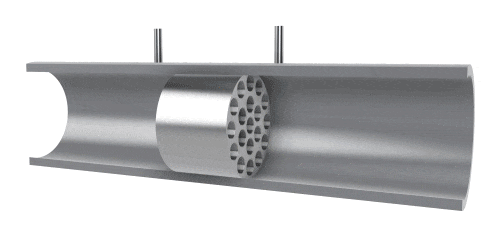
เครื่องวัดอัตราการไหลแบบความดันแตกต่าง (Differential Pressure Flowmeter) ซึ่งประกอบด้วยเซนเซอร์และเกจวัดความดันแตกต่าง ทำการวัดอัตราการไหลโดยตรวจจับความแตกต่างของความดันที่ปลายทั้งสองของเซนเซอร์ หลักการคือ เนื่องจากแรงยึดเกาะ (Adhesive Forces) การไหลของของไหลจะทำให้เกิดการสูญเสียพลังงานในรูปของความดัน ในกระบวนการไหลที่มีความเสถียร จะมีความสัมพันธ์ที่แน่นอนระหว่างการสูญเสียความดัน ความหนืดของของไหล และอัตราการไหล โดยความดันแตกต่าง (△P) มีความสัมพันธ์เชิงเส้นกับอัตราการไหลเชิงปริมาตร (Qv) เครื่องวัดประเภทนี้ส่วนใหญ่ใช้สำหรับการวัดอัตราการไหลขนาดเล็ก แต่เมื่อใช้กับของไหลที่มีความหนืดสูง ควรรักษาสภาวะการไหลแบบลามินาร์ที่เสถียร
▪ LORRIC มีเครื่องวัดอัตราการไหลหลากหลายประเภท ติดต่อเราเพื่อรับคำปรึกษาได้เลย!
[9]
เครื่องวัดการไหลแบบแม่เหล็กไฟฟ้า (Electromagnetic Flow Meters)
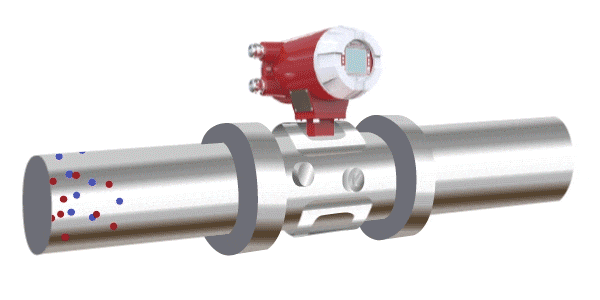
เครื่องวัดอัตราการไหลแบบแม่เหล็กไฟฟ้า (Electromagnetic Flow Meter) ทำงานโดยอาศัยหลักการของการเหนี่ยวนำแม่เหล็กไฟฟ้า โดยวัดการไหลของของไหลที่นำไฟฟ้าโดยตรวจจับแรงเคลื่อนไฟฟ้าที่เกิดขึ้นเมื่อของไหลไหลผ่านสนามแม่เหล็กที่ถูกสร้างขึ้น ขดลวดที่ติดตั้งอยู่ด้านบนของท่อจะสร้างสนามแม่เหล็ก และของไหลจะต้องมีไอออนที่มีประจุไฟฟ้า เมื่อของไหลไหลผ่านสนามแม่เหล็ก แรงเคลื่อนไฟฟ้าจะถูกเหนี่ยวนำขึ้นที่สองด้านของท่อ ซึ่งแรงเคลื่อนไฟฟ้านี้มีความสัมพันธ์โดยตรงกับความเร็วการไหลเฉลี่ย และใช้ในการคำนวณอัตราการไหล
▪ LORRIC มีเครื่องวัดอัตราการไหลหลากหลายประเภท ติดต่อเราเพื่อรับคำปรึกษาได้เลย!
[10]
เครื่องวัดการไหลแบบมวลความร้อน (Thermal Mass Flow Meters)
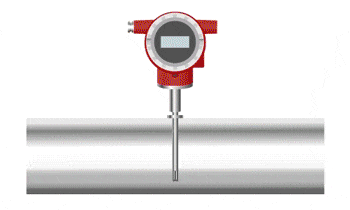
เครื่องวัดอัตราการไหลแบบมวลความร้อน (Thermal Mass Flow Meter) ประกอบด้วยท่อสองท่อ (หรือวัตถุอื่นที่สามารถให้ความร้อนได้) ซึ่งติดตั้งอยู่ในของไหล โดยท่อหนึ่งจะถูกให้ความร้อน และเมื่อของไหลสัมผัสกับท่อที่ถูกให้ความร้อน มันจะพาความร้อนออกไป ซึ่งทำให้อุณหภูมิของของไหลเพิ่มขึ้น การวัดการเปลี่ยนแปลงของอุณหภูมิระหว่างท่อทั้งสองช่วยให้สามารถกำหนดอัตราการไหลได้ หลักการนี้โดยทั่วไปต้องใช้เวลานานขึ้นเพื่อให้ระบบเข้าสู่สภาวะเสถียร
▪ LORRIC มีเครื่องวัดอัตราการไหลหลากหลายประเภท ติดต่อเราเพื่อรับคำปรึกษาได้เลย!
[11]